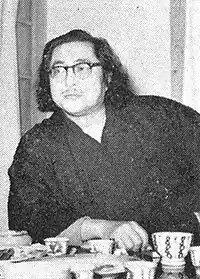
Mitsuru Nishikawa (西川 満, Nishikawa Mitsuru; 1908 February 12 – 1999 February 24) was a writer and literary figure during the Japanese rule in Taiwan.
Born in Aizuwakamatsu City, Fukushima Prefecture, Japan, he moved to Taiwan with his family during his childhood and returned to Japan for college. He returned to Taiwan shortly after graduation. When he was a senior in high school, Mitsuru Nishikawa established the poetry society Mori Poetry Society (杜の詩人社),[1] starting to produce poetry collections. Later, he embarked on his writing career and received multiple literary awards.
In addition to writing, Nishikawa was also active in newspaper editing and literary communities. He was an editor and head of the arts and literature department at the Taiwan Daily Newspaper. He also edited the Taiwan Book Lovers' Association's official magazine Love Books (愛書) and organized the Taiwan Association for Poets[2] and Taiwan Literary Arts Association, founding magazines such as Formosa (華麗島) and Bungei Taiwan (文藝臺灣). In April 1946, a year after Japan's defeat, Mitsuru Nishikawa was repatriated to Japan.
Activities
Returning to Taiwan after graduating from university, Nishikawa made extensive use of Taiwanese folklore material in his modern poetry. His collection of poems, Mazu Festival (媽祖祭), employed a variety of montage techniques, using Taiwanese vocabulary and Buddhist stories. Drawing on folk beliefs and legendary tales, Nishikawa developed prose poems rich in fantasy,[3] garnering reviews from many scholars and poets.[4] The birth of his eldest son, Jun Nishikawa (西川潤), and his focus on folklore inspired him to write fairy tales. He also adapted the history of Taiwan into novels. His representative work Chihkan Record (赤嵌記) won the Taiwan Literary Award in the first Taiwan Literature Awards. Towards the end of the war, Mitsuru Nishikawa wrote mainly about national politics, in line with the war efforts and policies of the Empire of Japan.[5]
Reference
- ↑ Li, Ya-shu (2011). "西川滿及其藝文團體" [Mitsuru Nishikawa and His Arts and Cultural Group]. Newsletter of Taiwan Studies (57): 5.
- ↑ Zeng, Wen-Liang (2009). "向南延伸的帝國軌跡 ——西川滿從〈龍脈記〉到《台灣縱貫鐵道》的台灣開拓史書寫" [The Empire's Trajectory Extending Southwards: Mitsuru Nishikawa's Taiwan Development History Writing from 'Dragon Vein Records' to 'Taiwan's North-South Railway']. Research in Taiwan Studies. 7: 77–96, 78.
- ↑ Chen, Yun-Yuan (2017). 殖民地前衛──現代主義詩學在戰前臺灣的傳播與再生產 [Colonial Avant-Garde: The Spread and Transformation of Modernism Poetics in Prewar Taiwan]. Taipei: Graduate Institute of Taiwan Literature, National Chengchi University. pp. 305–306.
- ↑ Nishikawa, Mitsuru (1978). "年譜4 『媽祖祭』の反響" [Chronology 4: The Resonance of 'Matsu Pilgrimage]. Andromeda (110): 8–9.
- ↑ Chang, Wen-Hsun (2012). "歷史小說與在地化認同-「國姓爺」故事系譜中的西川滿〈赤崁記〉" [Historical Novels and Localization Identity: Mitsuru Nishikawa's 'Chihkan Record' in the Genealogy of 'Koxinga' Stories]. Journal of Taiwan Literary Studies (14): 105–131.